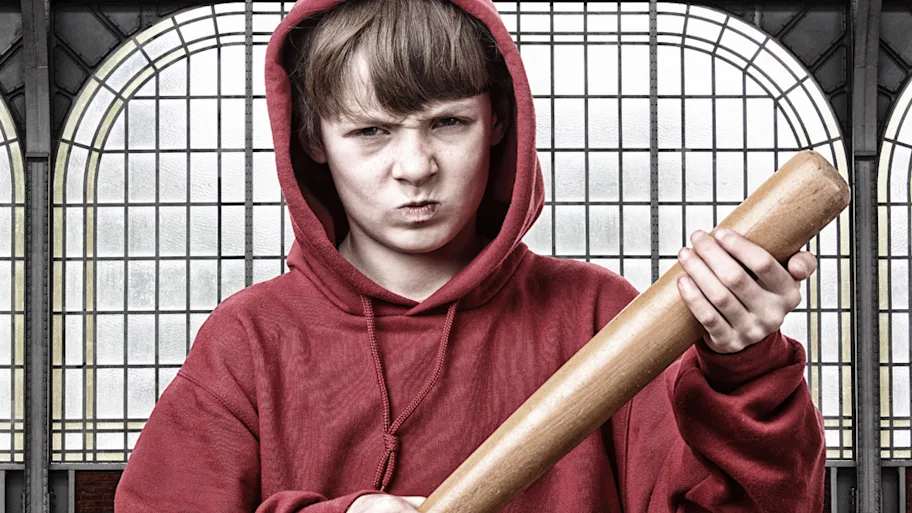
- Science news
- Featured news
- Justified and unjustified movie violence evokes different brain responses
Justified and unjustified movie violence evokes different brain responses
While gun violence in movies has been increasing, it has not been evident whether different types of violence elicit different brain responses. Image: Shutterstock
-- by the Annenberg Public Policy Center of the University of Pennsylvania
The gun violence seen in popular PG-13 movies aimed at children and teenagers has more than doubled since the rating was introduced in 1984. The increasing on-screen gun violence has raised concerns that it will encourage imitation, especially when it is portrayed as "justified."
What was not clear until now is whether justified and unjustified violence produce different brain responses.
Intersubject Synchronization of Late Adolescent Brain Responses to Violent Movies: A Virtue-Ethics Approach► Read original article► Download original article (pdf)
In a new study, researchers at the University of Pennsylvania find that scenes of unjustified and justified violence in movies activate different parts of the adolescent brain. This research is the first to show that when movie characters engage in violence that is seen as justified, there is a synchronized response among viewers in a part of the brain involved in moral evaluation, the ventromedial prefrontal cortex (vmPFC), suggesting that viewers see the violent behavior as acceptable for self- or family protection.
Performing fMRI scans of more than two dozen late adolescents who watched scenes of movie violence, the researchers also found that scenes of unjustified violence evoked a synchronized response in a different part of the brain. Activating that area of the brain, the lateral orbital frontal cortex (lOFC), is consistent with a disapproving response to the violence.
The research, led by a team at the Annenberg Public Policy Center (APPC) of the University of Pennsylvania, was published in the journal Frontiers in Behavioral Neuroscience.
"What this response suggests is that not all movie violence produces the same response," said senior author Dr. Dan Romer, APPC's research director. "Adolescents disapprove of movie violence that is seen as unjustified, which is consistent with what parents have reported in past studies. But when the violence seems justified, adolescents' brains appear to find it much more acceptable than when it is not."
Romer said the growth of movie violence and particularly the depiction of justified gun violence in movies raises concerns. "By popularizing the use of guns in a justified manner, Hollywood may be cultivating approval of this kind of entertainment," he said.
Viewing movies in an MRI scanner
For the study, researchers recruited a group of 26 college students ages 18 to 22, divided between men and women. All regularly watched violent movies and 70 percent played active shooter video games.
The researchers performed functional magnetic resonance imaging (fMRI) scans on the participants as they viewed movie clips. Each participant was shown eight pairs of 90-second movie clips from PG-13 or R-rated films. The clips featured a scene of characters talking followed by scenes of the characters engaged in violence. Half of the clips showed scenes of justified violence, the other unjustified violence. The order of scenes varied. The scenes of justified violence showed major characters engaging in the defense of friends, family or themselves, while the unjustified violence showed characters harming others out of cruelty or ill will. Prior evaluation of the scenes by parents and young adults confirmed that the scenes differed in justification for violence.
The researchers edited the scenes from the R-rated films to remove the graphic effects of the violence such as blood and suffering so that the scenes were more directly comparable to the violence portrayed in PG-13 movies.
The scenes of justified violence came from the PG-13 movies "Live Free or Die Hard" (2007), "White House Down" (2013), "Terminator Salvation" (2009), and "Taken" (2008). The clips of unjustified violence came from the PG-13 movies "Skyfall" (2012) and "Jack Reacher" (2012) and the R-rated films "Sicario" (2015) and "Training Day" (2001).
A synchronized brain response
The researchers found that watching the movie clips produced a synchronous response in brain activity among the study participants at the same points during the movie clips. But the brain activity differed when the participants were watching scenes of justified or unjustified violence.
"It was exciting to observe a synchronized reaction to these movie clips," said the study's lead author, Dr. Azeez Adebimpe, a former postdoctoral fellow at the Annenberg Public Policy Center. "Our findings clearly show that violent movies have similar effects on viewers."
The researchers found that scenes of unjustified violence evoked greater synchrony in a region of the brain that responds to aversive events (lOFC). They also observed synchrony in a region that responds to the experience of pain in either oneself or others, the insular cortex. That finding was consistent with an empathetic response to the pain experienced by the victims of this kind of violence, again suggesting that the violence was seen as unacceptable.
Related: Violent video games found not to affect empathy
Justified violence and the trolley problem
The ventromedial prefrontal cortex is the part of the brain that is activated when an individual is presented with a moral dilemma such as the trolley problem. This problem poses an ethical dilemma in which a runaway train is headed toward five people who are on the tracks. You can pull a switch and divert the train, which will kill one person on the alternate track - or you can take no action as the train races ahead toward five people. Most people see it as appropriate to save the five people and the ventromedial prefrontal cortex tends to respond as well.
In a different version of the problem, you can only stop the train from killing others by pushing an innocent bystander onto the tracks, which most people are unwilling to do. Research has shown that people who lack a functioning ventromedial prefrontal cortex are more willing to push an innocent person to death to save lives. The present study's results are consistent with this research in showing that the same brain region responds when the violence appears justified.
The findings are also consistent with a form of ethics based on evaluating an actor's character and motives, known as virtue ethics. Virtue ethics proposes that people judge behavior as acceptable - even when it might otherwise be seen as prohibited, as in harming others - when an actor has virtuous motives for the behavior. In the movie scenes with justified violence, the young viewers in the study rated the use of guns by the main character as more acceptable and their brains displayed a similar response.
The current research is consistent with previous APPC research that found that parents were more willing to let their children see the same movies clips when the violence appeared to be justified than when it had no socially redeeming purpose. This research also found that parents became more accepting of justified movie violence as they watched successive movie scenes that showed such violence.
Will justified screen violence encourage imitation?
In this MRI study, the researchers concluded: "The finding that brain synchrony discriminated between justified and unjustified violence suggests that even youth who are attracted to such content are sensitive to its moral implications. It remains for future research to determine whether the brain responses to justified film violence we have observed foster tendencies to imitate or consider the use of weapons for self-defense or other justified purposes. Laboratory research finds that justified film violence can encourage aggressive responses in response to provocation... What is less clear is whether the use of guns in movie portrayals of justified violence encourages their acquisition and use for purposes of self-defense."
In addition to Romer and Adebimpe, who is currently a postdoctoral fellow in Psychiatry at Penn, the study was conducted by Penn Bioengineering Professor Danielle S. Bassett, who is also an APPC distinguished research fellow, and Patrick E. Jamieson, director of APPC's Annenberg Health and Risk Communication Institute.
Original article: Intersubject Synchronization of Late Adolescent Brain Responses to Violent Movies: A Virtue-Ethics Approach






